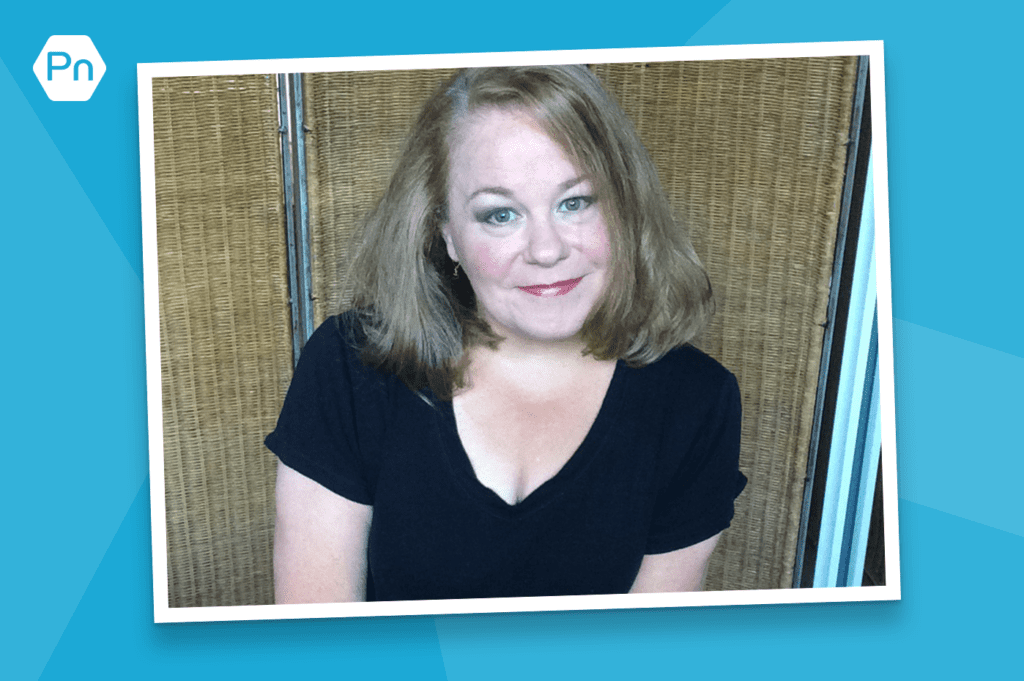The magazines got it wrong. Sure, the promise of “six-pack abs” might be motivating at the airport newsstand. But as soon as your flight’s delayed, it’s an easy goal to forget. Because stress, frustration, and… a conveniently-located Smashburger. (Same as every day, really.) There is a fix, though. If you’re willing to ask—and answer—some hard questions, you can discover a much deeper purpose for change. One that’ll ignite passion and drive you to get the results you want—no matter how badly the airline screws you.
++++
I could already see the pain in Michelle’s eyes as we sat down to talk.
“What are you hoping to achieve by hiring me?” I asked.
Michelle shrugged. “I just want to lose some weight and get fit again.”
After 10 years as a fitness coach, I knew there was more to the story. There always is.
“Have you always been overweight?” I asked.
She looked surprised at the personal question. I didn’t flinch.
After a moment, Michelle told me she’d been fighting her weight for more than 15 years. Now she has prediabetes.
“How does that make you feel?” I asked.
She hesitated again, but then said, “Scared. My mom was overweight and had diabetes, and I feel like I’m following in her footsteps.”
At this point, Michelle stopped holding back; tears trickled down her cheeks.
“It all hit me two weeks ago. My daughter said she didn’t trust me to be alone with my granddaughter because I’m too overweight and immobile to keep up. I was so devastated. So embarrassed.”
Many of us are like Michelle: Ashamed to talk about what’s really bothering us.
But since I started encouraging my clients to dig deep into their pain, their results have skyrocketed.
Why? Because to achieve real, lasting change, many people have to confront the emotional pain that’s making them want that change.
Once they do, their true motivation is crystalized. And that’s often far more powerful than any single exercise plan or diet approach.
The challenge is uncovering it.
++++
You never start with the pain.
When it comes to goals, people usually talk about losing fat or moving better or getting healthy. All fine aspirations, indeed.
But for many of us, these goals aren’t very meaningful in the context of our everyday lives. They’re more like health and fitness clichés.
Our true motivations run much deeper than having a “bikini body” or “sleeve-busting arms” (as the ads and coverlines promise).
That’s the surface level stuff we think we want.
Sure, these types of goals might inspire you to show up for six weeks of training and cut back on alcohol for a while. But for most people, how much do they really matter? How easy are they to give up on?
On the other hand… you know what’s way more motivating?
Michelle wanting to be able to take care of her granddaughter so badly that months of new habits, tiring workouts, and saying no to cupcakes in the break room seemed like the only choice. It wasn’t just a “look better” fitness goal—it was her burning passion.
Discovering why you really want to change gives you resolve.
A wise person (okay, it was Tony Robbins) once said: “Change happens when the pain of staying the same is greater than the pain of change.”
There’s just one problem: A lot of us never actually get to the root of what’s bothering us. We don’t face our pain because it’s uncomfortable. As a result, we’re much more likely to stay the same.
Find your pain… to stoke your passion.
Sometimes, pain will be obvious: divorce, a scary diagnosis, the loss of a loved one. This kind of pain is easy to identify. It’s right there in front of you, flagging you down.
Other times, pain can be more subtle: It’s hiding in a dark corner of the basement—always there, even if you aren’t constantly aware of it.
Maybe it stems from all those times you were picked last as a kid. Or from that “harmless” comment a loved one made about your body… or about someone else’s body (who looks like you).
These hits of pain may not feel that impactful in the moment, but over time, they accrue power and influence over your actions and self-worth.
The result? Pain that’s hidden can crop up as:
- avoiding activities that are fun or good for you, like going to a party or trying that new gym down the street
- feeling your heart race when someone asks if you’re okay
- revisiting some mortifying moment over and over, using it as evidence that you’re the worst
- turning down exciting opportunities because your inner voice says, ‘No way, I can’t do that.’
- living well into your 20s with the assumption you’ll never find companionship… because you got rejected on the middle school dance floor… and you assumed it was because the boys thought you were too big… so that must mean men don’t like you. (Is that TMI?)
These examples all suggest there’s trouble below the surface. Pain is discouraging you and holding you back. If you can access the source of this emotional discomfort, you can use it to achieve serious change.
Here’s how to do just that, in three steps.
Step #1: Find your true “why.”
Michelle wanted to lose weight, sure.
But more importantly, she wanted to be trusted to take care of her granddaughter. That was her real reason for wanting to lose weight.
In the Precision Nutrition coaching method, we call this “finding your why.”
Your “why” is the reason behind the reason… behind the reason… behind the surface reason you want to make a change in your life.
Finding your “why” is a shortcut to finding your pain.
Because often, your deepest reason for wanting to change your body or habits dredges up yucky stuff.
For example, the shame of having gained 30 pounds after having kids. (‘Why does every other mom seem to have it all together?’).
Or the helplessness of realizing you can’t even bend down to pick up a pencil off the floor.
Or the regret that comes with admitting you’re not the kind of active, inspiring father you want to be.
These are the “whys” that drive change.
Don’t settle for the easy answer.
Getting to your “deepest reason” requires some introspection. An exercise called the “5 Whys” can help kickstart the process.
Here’s how it works: Take your initial reason for wanting to make changes to your nutrition, workout routine, or lifestyle, and use that as a starting point.
Maybe you want to get fit. Now ask yourself “why?”
(If you’re a coach, you can go through this exercise with a client. You ask the questions, but let them do most of the talking.)
Keep asking—remember, it’s called the 5 Whys—until you feel like you’ve identified the real reason you want to change. The illustration below shows what this might look like.

Put in the work.
Some people can define—and confront—their “why” quickly. For others, it requires a little more time and effort.
Practicing meditation and/or mindfulness can help you access uncomfortable thoughts you’ve been avoiding or pushing away. To get started, try this simple mind-body scan.
Find a quiet place. Take 5 minutes and find somewhere you can be without interruptions. This could be just before bed or just after waking. Or in your office, resting on a park bench, or sitting in your parked car.
Notice physical sensations. Scan your body from the top of your head down to your toes, part by part. Note how you feel along the way. Don’t judge or rush to change anything.
Notice emotions and thoughts. Once you’ve done your “body scan,” do the same exercise for your emotions and thoughts. Again, don’t judge or try to make sense of it. Just observe.
Ask yourself 3 questions. Right now…
- What am I feeling physically?
- What am I feeling emotionally?
- What am I thinking?
You may find it helpful to jot down a few notes after each session. (It’s okay if you can’t find the perfect words.)
Over time, you’ll notice feelings, thoughts, and ideas that crop up consistently. These can be important clues to revealing your “why”… and your pain.
Step #2: Turn your pain into action.
Let’s start with an example.
When Nivi Jaswal entered Precision Nutrition Coaching, she was overweight, stressed, and had prediabetes. Through lots of reflection, Nivi uncovered the pain that was holding her back: a deep fear of not being good enough. If she couldn’t do something perfectly, she wouldn’t do it at all. So now what?
Do the hard thing.
Once you’ve defined your pain, you have a framework to experiment with an exercise PN calls “difficult-easy” and “difficult-difficult.” (No, those aren’t typos.)
Difficult-easy describes things you do that are hard, but still within your comfort zone: going to work every day even though you hate your job, for example. Or giving up carbs again even though you love pasta and cookies.
In Nivi’s case, difficult-easy was spending countless hours researching diet and exercise routines, looking for the “perfect” answer.
Difficult-difficult, however, is the stuff that’s truly challenging—the actions you shy away from because they seem overwhelming or even impossible. This is the place where you grow.
Here are some examples:
- For the mother who always prioritizes her family’s needs over her own, difficult-difficult might be carving out two hours per week for her favorite yoga classes.
- For the business executive who chooses to work 60 hours a week, difficult-difficult might be hanging out with friends twice a month (to start).
- For Nivi, difficult-difficult meant making small nutrition and lifestyle changes instead of going all-in. She was skeptical of this approach. It seemed like it wouldn’t work, and she was afraid she’d be wasting her time and effort. That’s what made it difficult-difficult.
Ask yourself:
What are you afraid of? Difficult-easy tasks tend to annoy us. Like when you say “yes” even though you don’t actually have any room on your plate for another task. Because saying “no” is too scary. The things that scare us are usually the difficult-difficult ones.
What would you do if it were Opposite Day? Difficult-easy stuff grinds you down, but you keep doing it anyway. Take a moment to consider: How’s that working for you? What could you do that’s new, that would force you to grow and put you on a new path? That’s your difficult-difficult.
Make one change at a time.
Once you’ve identified your difficult-difficult, chip away at it one small piece at a time. It might sound weird, but focusing on less can help you achieve more.
Pick one small, new habit.
Select one habit that supports progress toward the body and health you want. Make it something simple and reasonable, that you think you can practice every day.
Let’s say you want to get fitter, but you’re terrified of the gym because you feel like an outsider. Your difficult-difficult is hitting the gym on a regular basis.
Consider starting with a habit that gets you closer to that goal, but doesn’t go all the way.
For your first habit, you might choose one of these options:
- foam rolling for a few minutes every morning
- taking a 10-minute walk after dinner each evening
- doing a 15-minute home workout twice a week
- going to the gym once a week, but only committing to one exercise you’re comfortable with, and then leaving
Maybe one of these seems excruciatingly hard, while another is hard, but doable. Go with the latter.
Practice your habit.
Do your new habit every day for at least two weeks. Some days, it’ll feel like a grueling climb up Everest. Other days it may feel like you’re flying. Eventually, there’ll be more flying days than Everest ones. That’s how you know you’re ready for the next step.
Build on your habit.
Now maybe you’re ready for four home workouts per week, or two exercises when you go to the gym. Practice this new habit for another two weeks. Keep repeating this cycle.
With this practice, your difficult-difficult will become easier. As a result, you’ll get better at facing your pain and fears… and better at changing.
Step #3: Share your pain.
I once had a client named Nadia. Her commitment waxed and waned, and eventually she stopped showing up for workouts—a story any trainer knows all too well.
Two years later, Nadia asked if we could meet up. Over coffee, she explained she has a learning disability, but she’d been embarrassed to tell me about it before. During our workouts, she’d felt lost and anxious.
Armed with this new information, we figured out how to make her more comfortable this time around. She started showing up four days a week and made tons of progress.
Talking to people about your pain can:
- take some of the pain’s power away (you could realize you’re not at fault)
- make previously hidden solutions seem more obvious
- open up new sources of support that weren’t available before
- help you connect with people who are going through similar changes
- let others know that you’re open to help, if they’re able to provide it.
Start with the people you love.
Even once Michelle opened up to me, she still had no intention of telling her husband or her daughter about her pain. At first, she didn’t even tell them she had joined a gym.
After a few months, she’d lost some weight, but her motivation started to dwindle, and she was still angry at her daughter. I asked her what she thought might happen if she talked to her daughter about it.
“I was really hoping to avoid conflict,” she said.
What resulted was the opposite. Michelle’s daughter and son-in-law were highly encouraging. In fact, both committed to making nutrition changes with her to show their support. Michelle’s husband even purged all the junk food from their house.
While there are no guarantees, most of the time, if you allow yourself to be vulnerable with the people you’re close to, they’ll rally to support you.
And that can make all the difference in continuing to make progress.
Give yourself permission to take it slow.
If you don’t feel ready to reveal your pain to someone else just yet, you can use the principles of stress inoculation training (SIT) to help you start sharing little by little.
SIT is like a stress vaccination. The basic idea is to slowly get comfortable being… uncomfortable.
Think of it like this: Exposing yourself to small amounts of stress regularly—in levels that don’t overwhelm you—trains you to handle much tougher situations. Just like with exercise.
In this case, tell your story in pieces, at your own pace, until you start to adapt to the stress of sharing. Or maybe reveal your pain in a journal first, then with a stranger, and then with someone you’re close to.
Because you can do this alone, but you don’t have to.
If it feels a little uncomfortable, you’re on the right track.
Remember, we call it difficult-difficult for a reason.
But if you’re willing to dig deep, find your why, and uncover the root of your pain, you may discover the purpose and passion you’ve been missing.
So move past thinking you “just want to get fit” or “can’t lose weight.” And open yourself to the possibility there’s more to the story.
That’s where you’ll find the motivation you really need… for the results you really want.
Want help becoming the healthiest, fittest, strongest version of you?
Most people know that regular movement, eating well, sleep, and stress management are important for looking and feeling better. Yet they need help applying that knowledge in the context of their busy, sometimes stressful lives.
Over the past the past two decades, we’ve used the Precision Nutrition Coaching method to help over 150,000 clients lose fat, get stronger, and improve their physical and mental health… for the long-term… no matter what challenges they’re dealing with.
It’s also why we work with health, fitness, and wellness professionals (through our Level 1 and Level 2 Certification programs) to teach them how to coach their own clients through the same challenges.




Share